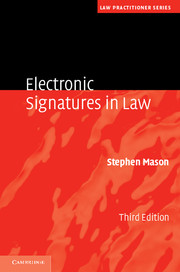Book contents
- Frontmatter
- Contents
- Preface
- Acknowledgements
- Table of cases
- 1 The signature
- 2 International initiatives
- 3 European Union Directive on electronic signatures
- 4 England and Wales, Northern Ireland and Scotland
- 5 International comparison of electronic signature laws
- 6 The form of an electronic signature
- 7 Digital signatures
- 8 Liability
- 9 Evidence
- 10 Data protection
- Index
- References
5 - International comparison of electronic signature laws
- Frontmatter
- Contents
- Preface
- Acknowledgements
- Table of cases
- 1 The signature
- 2 International initiatives
- 3 European Union Directive on electronic signatures
- 4 England and Wales, Northern Ireland and Scotland
- 5 International comparison of electronic signature laws
- 6 The form of an electronic signature
- 7 Digital signatures
- 8 Liability
- 9 Evidence
- 10 Data protection
- Index
- References
Summary
The framework within which legislation is drafted invariably depends on the decisions made by politicians. While the existence of the UNCITRAL Model Law on Electronic Commerce and Model Law on Electronic Signatures have acted as a guide for many states when enacting legislation, other factors help shape the formation of legislation, such as the approach taken regionally by the European Union in the form of the Directive on electronic signatures. In early reports published by the Internet Law and Policy Forum, it was suggested it is possible for there to be a tension between legislation that seeks to be technologically neutral and the establishment of legal rules to provide for electronic authentication. The tension is illustrated in the judicial reaction to electronic signatures. This is because electronic signatures do not appear to be well understood in some jurisdictions (by lawyers or judges), and in what might be called civil law jurisdictions (although not exclusively), the emphasis is on the acceptance of digital signatures to the exclusion of other forms of electronic signature (although the PIN is universally accepted, which illustrates the irrational approach taken to digital signature). Of interest, a number of countries have decided to specifically exclude some forms of electronic signature, that is, signatures by facsimile or by way of a scanning device.
Approaches to legislation
There are three broad approaches to legislating for electronic signatures: the prescriptive approach, the minimalist approach and the two-tier approach. Each is discussed below.
- Type
- Chapter
- Information
- Electronic Signatures in Law , pp. 153 - 186Publisher: Cambridge University PressPrint publication year: 2012

